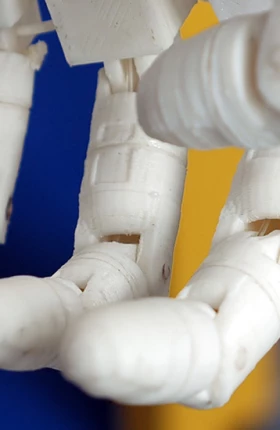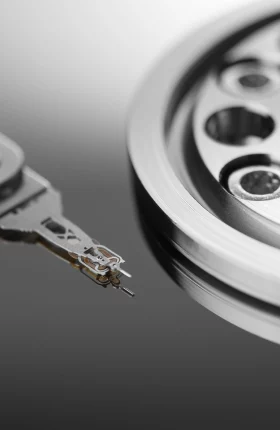Industry 4.0 digital innovations, from advanced data analytics to intelligent networks, offer tremendous opportunity to create value and raise the efficiency of production processes. Yet few cement producers have implemented 4.0 advances in any systematic way. Producers that move quickly to employ 4.0 technologies can therefore gain a powerful competitive advantage over their peers.
Industry 4.0’s Competitive Advantages
The fourth industrial revolution, or Industry 4.0, exploits new technologies to create powerful connections between physical and digital systems. A number of manufacturing industries have already implemented 4.0 solutions to good effect. Mining companies, for example, are using data about equipment health to predict potential failures, while aeronautics and automotive companies are using robotics and end-to-end digital twins to improve their design and production processes. Not surprisingly, first adopters in many industries have gained an edge over their competition.
Cement production can also be enhanced by Industry 4.0 in a number of ways. (See Exhibit 1.) In particular, 4.0 solutions can better manage the enormous energy consumption, rising cost challenges, and overall process complexity that are inherent to the industry. For instance, cement companies today must rely on engineers’ gut feel and data from prior production batches (typically after a delay of several hours) to estimate end-product quality. In contrast, 4.0 solutions employ extensive real-time data, historical data sets, and models to help manage and predict outcomes. Many cement players know the benefits of 4.0, but few have seen its full power or taken advantage of its full potential. The first movers in this industry will generate substantial value and build a strong competitive lead.
Five 4.0 Cement Priorities
Among the many Industry 4.0 solutions on offer, we believe that five in particular hold the greatest potential for cement manufacturers today. The sections that follow examine these five priority areas.
Analytics-Driven Predictive Maintenance. The first 4.0 priority, predictive maintenance, helps producers address maintenance issues in advance of equipment breakdown—thereby preventing extended downtime, avoiding unnecessary damage, improving operational efficiency, and reducing maintenance costs. It allows operators to stop production for just a few minutes each month, for example, to replace a fan that’s about to break, rather than replacing each fan every year whether it needs it or not.
To implement systematic 4.0 predictive maintenance, cement companies must first equip all critical machines with sensors that monitor in-use equipment conditions, such as vibration, temperature, and pressure. They should then aggregate the data from these sensors into repositories, or “data lakes.” In addition, they should establish the performance thresholds that will trigger maintenance whenever the value from a sensor goes beyond the relevant threshold. Finally, they should use machine-learning algorithms to analyze historical data, run simulations, uncover the root causes of past failures, and predict the risk of failure for each machine.
Predictive maintenance can add value to three primary installations in a cement plant—the gear boxes; the mills, which are expensive and numerous; and the kiln, which requires long interventions in cases of breakdown and must be shut down for several weeks each year to replace the refractory lining.
One global oil and gas company implemented a predictive approach that allows it to monitor each installation’s integrity, along with its probability of breakdown. The data obtained helps the company plan maintenance campaigns ahead of time for all the installations in a given region. As a result, the company has been able to manage all maintenance and construction work centrally, reduce the personnel aboard its rigs and production vessels by about 50%, and cut maintenance costs by approximately 20%.
End-to-End Optimization via Digital Twin. The digital twin allows cement companies to mirror the entire production process through a digital model—a “twin” of the plant’s physical assets, processes, and systems—and use artificial intelligence (AI) and machine learning to optimize it.
Dozens of variables come into play in the cement production process, from the quality of the limestone and the coal’s chemical properties to the type of fuel in the kiln and the desired quality and cost of the end product. Most cement players work to optimize these variables at each step in the process; however, optimization across all variables and steps is arduous, and true optimization is impossible with traditional tools.
The digital twin resolves this issue by simulating the production process in a simplified and dynamic way, thus allowing the production site to generate scenarios that change with each process step and variable. This digital model can propose the optimal equipment settings for achieving the site’s output targets, for example, including the settings to achieve the lowest possible cost while maintaining certain quality or machine parameters.
Perhaps most important, AI software now allows such systems to learn and improve with each experience. As the machine learns, it can make data-driven predictions or decisions without being reprogrammed.
The earliest adopters of the digital twin were aerospace and defense companies, which used this solution to test component behavior without the high cost of creating prototypes and potentially damaging them. Digital twins have since been successfully implemented in mining, construction, and other industries as well. For example, a global copper producer built a digital twin of its grinding and milling process that gathered two years of data on 500 variables and used several algorithms to create new mill-optimization scenarios. Although the company had already enhanced its mill operations extensively, it was able to increase its equipment utilization ratio by an additional 3.5% over its earlier improvements.
Cement producers should build the digital twin step by step, starting with one subprocess and adding others until the full production process is incorporated. As the simulation progresses, the machine can begin to make predictions, linking with other 4.0 innovations such as data analytics and the Internet of Things to reach the desired level of digital replication. Eventually, the simulation should be able to make real-time predictions, as well as adjustments in the way the equipment is being run, across the entire production line.
Predictive Quality Analytics. Predictive quality models can allow a company to accurately forecast cement quality in real time at any point in the production process, reducing the overspending that is typical in efforts to meet quality targets.
In the traditional cement factory, it is impossible to estimate cement strength with any certainty until its 1-day and 28-day strengths are measured through physical tests. Producers tend to compensate by using costly, high-quality limestone and additives to ensure a high-performing product. Alternatively, they may mill the product more extensively, as the fineness of the grind is another factor in final strength. Not only are these approaches expensive, they offer no way of taking into account the multitude of other production process variables that can affect cement quality. (See Exhibit 2.)
In contrast, predictive quality models use machine-learning algorithms to correlate the quality of each production batch with the relevant production parameters. As noted, the variables involved in final cement quality are numerous and intertwined.
Given their interdependency, it is difficult to determine the impact of each factor at every step. AI lets the system learn, over time, to associate all of the process input parameters and the raw material characteristics with the quality outcome.
As a result, producers can build a predictive model that transforms the necessary quality of the final product from an output of the process into an input that guides decision making at every step of the way. In addition, producers are able to understand the root causes of any product quality issues and make highly informed spending decisions—choosing the least costly element required at each step of the process to achieve the desired quality.
Alternative Fuel Optimization. Analytics can also optimize alternative fuel consumption, reducing costs and improving a cement business’s environmental footprint.
Energy expenditures represent 45% or more of total cement production costs, a portion that manufacturers could cut in half by using alternative fuels. Although use of alternative fuels is growing, it remains low. On the basis of data from three of the leading global cement players, we estimate that alternative fuels account for only 17% of the industry’s overall fuel use globally, and less in developing countries. Reasons for the low uptake include the need to achieve a constant supply and consistent quality of fuel, and the requirement that the fuels used do not harm the clinker.
If the industry is to increase its use of alternative fuels, it must gain greater control of process variability, given both the inherent instability of any chemical process and the complexity of the cement manufacturing process in particular. It can achieve this through more accurate predictions of calorific value and optimization of fuel blends, which can be accomplished in four steps.
- Collect data on chemical composition and kiln performance under different fuel settings, as well as information on the effects of exhaust fumes on the temperature and air composition in the heater and preheater areas.
- Create a calorific prediction model, and then run it using an initial set of categories and quantities of alternative fuels to simulate potential calorific outcomes and costs. Afterwards, the model can be run using other alternative fuels as desired.
- Set up a full machine-learning algorithm using data analytics to predict the amount and type of fuel required to achieve a given production and cost outcome.
- Finally, render the model dynamic through the use of artificial neural networks, allowing the machine to adjust itself automatically and pull a mix of alternative fuels into the kiln as needed to ensure the optimum quality outcome for a given cost level.
One global cement player is in the process of using Industry 4.0 innovations to increase its alternative fuel usage; over a quarter of the company’s plants are already using more than 50% alternative fuels. The company aims to be the first to have all of its plants running on 100% alternative fuels sometime in the next decade, with a short-term goal of having half of its plants doing so by 2021.
The Integrated Control Tower. Finally, producers should run their new digitized cement factory remotely via an integrated control tower. Few cement companies have ICTs in operation today, but those that do have realized important benefits, including reductions of up to 15% in operating costs, significant workforce optimization, lower maintenance costs, and improvements in safety and working conditions.
Every cement plant today monitors the manufacturing process from several control rooms, and all adjustments and decisions are taken by the people in the control rooms as they react to changes in machine and process variables. In contrast, the ICT employs scenario software to proactively run the process as closely to the desired ideal as possible. (See Exhibit 3.)
Although there will always be uncontrollable variables, an ICT is able to adjust most variables dynamically and in relation to each other as limestone goes through the cement production process. For example, the spacing of separators in a cement plant’s cooler is usually preset. As one batch is completed, staff may adjust the spacing to improve the quality of the next batch. With an ICT, producers can automate the system to first determine the optimal cooling procedure for the current set of raw materials and then adjust the separators in real time to match new parameters.
A fully enabled ICT could run the entire plant remotely—monitoring equipment conditions, predicting failures, planning maintenance operations, and choosing the optimal settings and inputs. In addition, the ICT could eventually expand to control multiple production sites. One global mining group, for example, is running several of its operations from an ICT at its headquarters. The tower helps in monitoring the ongoing production process, responding to deviations in the mines, and planning centrally led support interventions.
An ICT can also improve internal collaboration by empowering staff to manage real-time deviations and by creating a strong support loop for the onsite operational teams. These teams are able to rely more, and more directly, on support functions and experts that might otherwise take too much time and energy to reach.
Putting 4.0 into Practice
Cement manufacturers should take a structured approach to implementing 4.0 solutions. The following guidelines can help.
- Grasp the current situation. Companies should begin with a comprehensive digital health check to understand their true starting point. Is data being collected? If so, is the company storing it in a structured database? Is the data being used for decision making?
- Set the vision. Next, the company should decide exactly what it wants to accomplish and how it will go about doing so. Is the intent, for example, to boost yield, increase productivity, or create a best-in-class plant?
- Conduct pilots. Most successful implementations of Industry 4.0 begin with pilot programs. By testing the new technologies in a real-life cement production context, manufacturers can identify the requirements and challenges and choose the best way forward.
- Create a reference factory. Before a general rollout, producers should designate a single plant for testing and initial rollout of all technologies. This plant becomes the reference cement factory. Using a reference plant generates two important benefits. First, it establishes seamless integration and functioning of the new technologies before the broader rollout. Second, it provides an early lighthouse for change, embodying the corporate vision.
- Establish strong governance. A successful rollout of Industry 4.0 across all plants requires strong governance and a central approach to change management—involving not just the affected sites but all central functions. Without clear governance, sites and regional business units may design different concepts, or efforts might be duplicated. A strong central steering committee, led by the CEO, can ensure homogeneous implementation, avoid duplicate spending, and capitalize on existing systems and solutions, thus accelerating the implementation.












